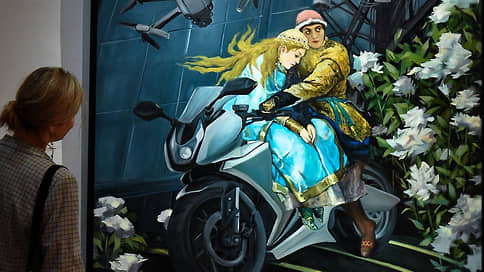Foreign ensemble – Newspaper Kommersant No. 175 (7376) of 09/22/2022
[ad_1]

The exhibition “Artifacts and Gadgets of Elena Kovylina” has opened at the All-Russian Museum of Decorative Arts. The artist, once famous for her bold performances, endows antiquities with unexpected functions and looks for prototypes of modern things and devices in them. I peered into museum artifacts and paintings by Elena Kovylina Igor Grebelnikov.
The exposition is arranged effectively. Through a turnstile borrowed from the subway, the viewer enters a hall with subdued light, where he rests against a carpet thrown over the podium and a huge panel: four red horses gallop across the surface of the planet, escaping from the flames. The picture is reminiscent of an old television screensaver: a video in which horses raced around the planet preceded news releases on the Rossiya channel in the 1990s. Without hellfire, of course, but times are different now. Under the painting is a showcase with foil helmets: visitors are invited to put them on and get involved in the game, become a character in a hoax that unfolded over several halls.
All this is quite unexpected. Glory to Elena Kovylina in the 2000-2010s brought art of a completely different kind. After studying at the F+F School of Art and Media Design in Zurich, she returned to Moscow and took up performances on the most relevant topics for contemporary art – the body, identity, feminism, politics, social problems. And now some of the early works make a strong impression (a selection of documentation of Kovylina’s performances in the form of photographs and videos is shown in the Ilona-K Artspace gallery). Then the artist participated with them in many exhibitions and biennials, including foreign ones, but, alas, she was never awarded a large solo exhibition in her homeland. “Now is not the time for performances,” says Kovylina.
Having got the opportunity to work with the collection of the Museum of Decorative Arts (the project was implemented with a grant from the Presidential Fund for Cultural Initiatives, curated by Alina Saprykina), the artist thoroughly sorted out its bins – from stirrups and saddles to spinning wheels, spoons, cradles, lace, handkerchiefs – grouped things thematically (decor, comfort, clothing, nutrition, hygiene, martial arts) and supplemented them with modern items of the same purpose.
Each hall is a huge showcase, which houses museum artifacts, and paintings by Kovylina are hung around the perimeter of the walls. Plots – fantasy, style – poster: next to the characters and objects from fairy tales – modern technology, equipment, gadgets. The Sirin bird flaps its wings in Earth orbit near the space station; Elena the Beautiful flaunts in a kokoshnik against the background of a dish antenna on top of a mountain; in front of the windshield of the car – a bright yellow ball, he is here as a navigator; flying carpet is the same as a drone. The canvases are reflected in the mirrors placed inside the showcases, in the corner of each picture there is an ornament, and not a simple one, these are fractal antennas: in this way, according to the artist, the works are “chipped, like many other things in the modern world.”
In general, there is something to make your head spin (if you do not wear a foil helmet). Kovylina’s hypothesis, which formed the basis of the project, is that “geometric ornaments inherent in applied art are microcircuits, a working element of some technological system that has been lost.” That in ancient times, when a kokoshnik could act as an antenna, it was no worse. And the geometry of Russian folk patterns will come in handy even now: the artist refers to the experience of the American scientist and inventor Nathan Cohen, who in 1988 proposed a fractal antenna, the shape of which resembled an ornament, thanks to which the radio signal was better caught. Today, fractal antennas are not used anywhere for wireless communication. And even to display items of folk culture.
It is difficult to say how folklore researchers will meet Kovylina’s ideas: fairy tales, myths, ornaments have been diligently studied since the beginning of the 19th century. But for a museum designed to captivate the public with a collection of apparently not the most exciting gizmos, such an artistic hoax is just right. There have been periods of close interest in folk art in history. At the beginning of the 19th century in Europe, the collection and study of folklore coincided with the growth of national movements, fairy tales and legends fueled romanticism. At the beginning of the 20th century, primitive art inspired avant-garde artists, although not all of them: to recall at least the programmatic essay “Ornament is a Crime” by the great Austrian architect Adolf Loos. Given the historical experience, folk art today should be handled with care. But the genie seems to have been let out of the bottle: “Artifacts and Gadgets of Elena Kovylina”, although it seems to be a hoax, fully reflects the bleak state of contemporary art in Russia. When not only a performance, but also any free expression can easily turn out to be a crime, the artist has little choice: to illustrate fairy tales, simultaneously blowing dust off stale museum exhibits.
[ad_2]
Source link






